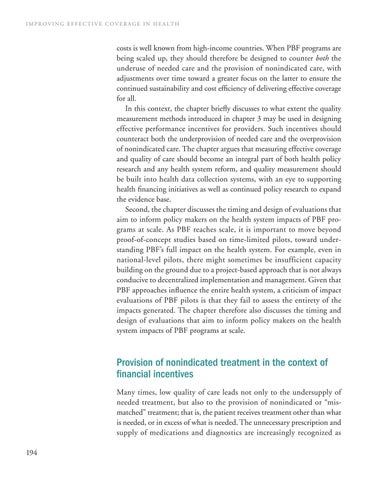IMPROVING EFFECTIVE COVERAGE IN HEALTH
costs is well known from high-income countries. When PBF programs are being scaled up, they should therefore be designed to counter both the underuse of needed care and the provision of nonindicated care, with adjustments over time toward a greater focus on the latter to ensure the continued sustainability and cost efficiency of delivering effective coverage for all. In this context, the chapter briefly discusses to what extent the quality measurement methods introduced in chapter 3 may be used in designing effective performance incentives for providers. Such incentives should counteract both the underprovision of needed care and the overprovision of nonindicated care. The chapter argues that measuring effective coverage and quality of care should become an integral part of both health policy research and any health system reform, and quality measurement should be built into health data collection systems, with an eye to supporting health financing initiatives as well as continued policy research to expand the evidence base. Second, the chapter discusses the timing and design of evaluations that aim to inform policy makers on the health system impacts of PBF programs at scale. As PBF reaches scale, it is important to move beyond proof-of-concept studies based on time-limited pilots, toward understanding PBF’s full impact on the health system. For example, even in national-level pilots, there might sometimes be insufficient capacity building on the ground due to a project-based approach that is not always conducive to decentralized implementation and management. Given that PBF approaches influence the entire health system, a criticism of impact evaluations of PBF pilots is that they fail to assess the entirety of the impacts generated. The chapter therefore also discusses the timing and design of evaluations that aim to inform policy makers on the health system impacts of PBF programs at scale.
Provision of nonindicated treatment in the context of financial incentives Many times, low quality of care leads not only to the undersupply of needed treatment, but also to the provision of nonindicated or “mismatched” treatment; that is, the patient receives treatment other than what is needed, or in excess of what is needed. The unnecessary prescription and supply of medications and diagnostics are increasingly recognized as 194

